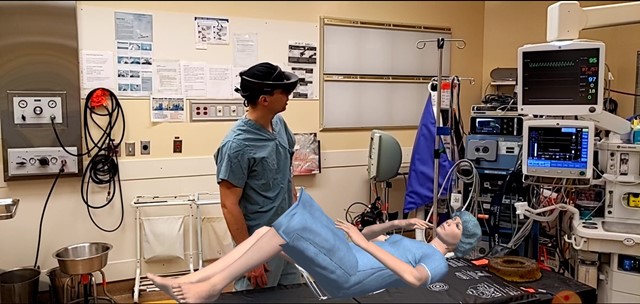By Monica Matys
Virtual reality systems are increasingly finding their place in health care. They allow patients to “see” and experience stressful medical procedures in a safe space before their actual treatment. Research has shown that by knowing what is involved in the process, this can help ease a patient’s concerns and anxiety.
New systems in development are now hoping to train future health care workers from literally anywhere.
Sunnybrook’s Collaborative Human Immersive Interaction Laboratory has been advancing virtual reality for years, and three of the experts involved provide an update on their exciting work.
-Dr. Fahad Alam, Co-Founder, Collaborative Human Immersive Interaction Laboratory (CHISIL)
-Dr. Julian Wiegelmann, Anesthesiologist, AR Development Lead
-Dr. Bill Kapralos, Associate Professor, Ontario Tech University
How is VR is currently being used at Sunnybrook?
Fahad: We’ve been using VR for various applications. For example, some patients who are anxious about having surgery, or certain medical procedures, can first go through the steps virtually. In our studies, we’ve found this approach decreases the anxiety that patients feel, and actually improves their outcomes.
So what’s the latest system you are working on?
Fahad: There are a lot of medical emergencies that can happen, so we’re creating an AR system called HoloSIM that will literally immerse the learner inside one of their choosing; things like cardiac arrest or anaphylactic shock. A special headset is worn that interacts with sensors in the room, so learners can walk around and control the simulated environment with their hands and movements. If a mistake is made, they can see the patient’s vital signs will react. That feedback can all be reviewed afterwards as part of the learning experience.
Julian: Right now, HoloSIM is in the prototype stage. The idea is that any room a medical student is in can be used for training by overlaying interactive holographic resources onto it. We’re currently working on creating a platform in this system where different variables can be changed, like medical props and types of patients, and their physiology can be adjusted to any parameter to simulate almost any situation in health care.
Bill: What’s great about this is you’re not stuck to one static scene. Educators can come in and develop new scenarios or modify existing ones.
Are there limitations?
Julian: Right now, the HoloSIM system responds to some hand gestures and head movements, but there are still many interesting problems that need solving. For example, how do you convey a sensation like pulse when it’s something the learner can’t actually touch?
Bill: The plan is to develop a pair of gloves that deliver haptic feedback, or touch sensation. But we’re not there yet. Right now, we’re also unable to realistically convey smells that are authentic to various environments.
So how realistic is the experience a person is getting?
Fahad: It’s quite realistic, I’d say at least 80% for AR.
Bill: Yes, and with VR you definitely feel immersed in it. While there’s still work to be done on the haptic side of VR, the cognitive decision-making side is very realistic.
Sunnybrook has a Simulation Centre that uses mannequins to train students. How do VR and AR fit in?
Fahad: The SIM Centre definitely plays an important role, and in the future, maybe these two worlds can connect. For example, bringing students into the SIM Centre, and using AR to overlay different scenarios.
Bill: VR and AR technologies allow us to develop additional training tools. Since the haptic side of training still isn’t totally realistic yet, currently these tools can, for example, be used to prep students before their experience in the SIM Centre.
Fahad: And there are benefits for remote students with AR and VR, as you can literally do the training anywhere. As the technology advances and gets more affordable, hopefully we’ll see more and more people at home with these special goggles and headsets.
Do you wish VR and AR existed during your own medical training
Julian: Absolutely! I recently completed my anesthesia training, and that’s why I’m creating the HoloSIM technology. You realize that you’ll never encounter all of these different crisis scenarios in real life during your training, so this software would have helped put me in the hot seat to practice in a safe environment. While HoloSIM is still in the testing phase, the hope is to roll it out to our anesthesiology residents by early 2020.
Fahad: As long as this is developed properly, it’s can be such a great training tool. Imagine as a student, during 15 minutes of downtime, popping on a headset and doing a run through of any procedure.
Bill: Plus, this is a really engaging, immersive and fun way of learning.


